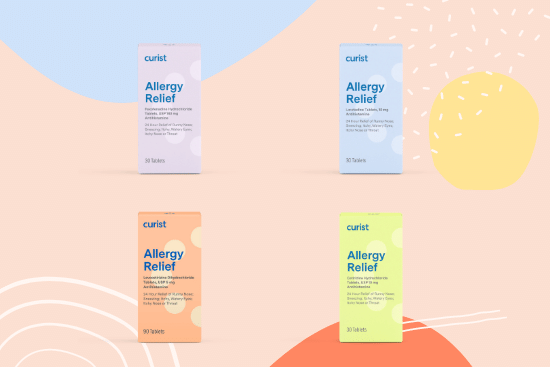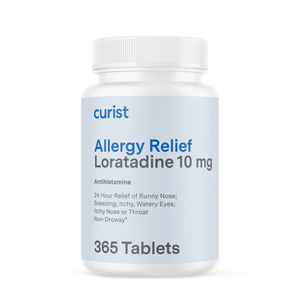By Deni Hui, The University of Texas at Austin College of Pharmacy
Curist delivers over-the-counter medicines to your door at a fraction of the price of traditional brands. We hope everyone stays safe and healthy during this time.
As you may have already known, you have several over-the-counter (OTC) and prescription options to choose from when it comes to treating allergy symptoms. In this article, we will be looking at the four most commonly used OTC medications indicated for allergic symptom relief and discuss their similarities and differences.
What are Histamines?
Before talking about antihistamines, let’s understand what histamines are and how they work. Histamine is a chemical made by your immune system and it plays a key role in your body’s allergic response. When you have allergies (triggered by pollen, ragweed, pet dander, or dust), they may seem harmless to you, but your immune system sees them as a threat and responds by making histamines. More specifically, histamines are part of your body’s defense system. They help your body by getting rid of the allergy trigger or “allergen”. However, when histamines overreact to an allergen, it can cause unpleasant symptoms including itchy, watery eyes, runny nose, skin rashes, hives, and/or sneezing.
What are Antihistamines? How Do They Work?
Antihistamines are a class of medications commonly used to treat symptoms of allergies. Their chemical structures are similar to those of histamines. They work by blocking or reducing the histamine-mediated effects (your allergy symptoms) at those histamine binding sites, which reduces the allergy symptoms that people typically feel like sneezing or itchiness.
Are Allegra, Claritin, Xyzal, and Zyrtec the Same Thing?
Allegra, Claritin, Xyzal and Zyrtec are not the same medicine, but are very similar as they are all oral antihistamines. Yes; Allegra (fexofenadine), Claritin (loratadine), Xyzal (levocetirizine), and Zyrtec (cetirizine) are all considered newer antihistamines because they were designed to be safer than first generation antihistamines like Benadryl (diphenhydramine) as they do not cause drowsiness and interact with fewer drugs. These newer generation antihistamines are also shown to be more effective in allergic symptom relief than first generation antihistamines.
What is the difference: Allegra vs Claritin vs Xyzal vs Zyrtec?
So while Allegra (fexofenadine), Claritin (loratadine), Xyzal (levocetirizine), and Zyrtec (cetirizine) are all newer generation antihistamines that can treat allergy symptoms, hay fever, skin rashes or even hives, there are differences between these antihistamines. Let’s take a look!
Allegra, Claritin, Xyzal & Zyrtec: Allergic Medication Dosage
First and foremost, Allegra, Claritin, Xyzal and Zyrtec work best when taken daily rather than intermittently. They usually begin to work as quickly as hour 1 on the first day you take it and provide 24-hour relief, all day and all night. All of these antihistamines are indicated for adults and children 2 years of age and older. Allegra, specifically, can also be used in children as young as 6 months of age and it is sometimes the ideal choice for young children.
If you are also taking other OTC or prescription medications, make sure to consult your healthcare provider first about the best way to take these antihistamines.
Allegra, Claritin, Xyzal & Zyrtec: Pregnancy and Lactation
Allegra (fexofenadine), Claritin (loratadine), Xyzal (levocetirizine), and Zyrtec (cetirizine) should be used during pregnancy only if clearly needed. As of now, there is no controlled data in the use of oral antihistamines in human pregnancy. Even though these OTC allergy medications seem to be safe and may be fine to keep taking during pregnancy, it is important to discuss with your healthcare provider so you can have a peace of mind.
Zyrtec (cetirizine) is the preferred antihistamine when breastfeeding. Other antihistamines like Allegra (fexofenadine), Claritin (loratadine), and Xyzal (levocetirizine) are also considered safe but do not have as much research to support this.
Allegra, Claritin, Xyzal & Zyrtec: Side Effects
Allegra (fexofenadine), Claritin (loratadine), Xyzal (levocetirizine), and Zyrtec (cetirizine) are all considered well tolerated medications with minimal side effects. The side effect profile of each of these medications may vary slightly but it is possible though rare to experience blurred vision, confusion, dry mouth, drowsiness, dizziness, nausea or vomiting. Allegra and Claritin are considered non-drowsy, Xyzal is minimally drowsy (drowsiness occurs in only a small number of cases), and Zyrtec can cause drowsiness.
Which Works Better for Allergy: Allegra, Claritin, Xyzal or Zyrtec?
The best antihistamine choice for you can vary depending on the degree of symptom relief you desire and the degree of side effects you are willing to tolerate.
For mild to moderate allergy symptoms, Allegra or Claritin are preferred because they are non sedating and do not make you feel sleepy. For more severe symptoms that can interfere with work, school or daily activities, Xyzal or Zyrtec may be more effective.
Since every person is different, some of us may experience fatigue on these newer antihistamines while some may not. It can be helpful to try different medications to see which works best for you as an individual.
Besides treating allergy symptoms, Allegra, Claritin, and Xyzal can be equally effective in treating hay fever and allergic skin rashes. Xyzal and Zyrtec, on the other hand, are considered to be more effective for the treatment of hives.
Can I Take Two Antihistamines at the Same Time?
No, it is not recommended to take two antihistamines together at the same time. You should only pick one antihistamine and take it daily, as they each work better to control symptoms taken daily. Having said that, do not “double-up” on a dose. Do not take a dose sooner than you’re supposed to. Do not take two different antihistamines at the same time. Instead, if an antihistamine alone is not enough to treat your symptoms, some allergy doctors suggest pairing the antihistamine with a nasal steroid allergy spray for additional allergy relief. Please consult with your doctor or pharmacist first if you have trouble finding a medication that works well for your allergy symptoms.
Where Can I Buy Allegra, Claritin, Xyzal, and Zyrtec?
The over-the-counter versions of fexofenadine, loratadine, levocetirizine, and cetirizine are available in local pharmacies as well as stores online like Curist, and do not need a prescription.
At Curist, we develop FDA-approved equivalents to big brands in order to provide the same medicine relief but at half the price of the brands. Curist products are sold online and shipped directly to your door, and we carry fexofenadine (compare to Allegra), loratadine (compare to Claritin), levocetirizine (compare to Xyzal), and cetirizine (compare to Zyrtec).












